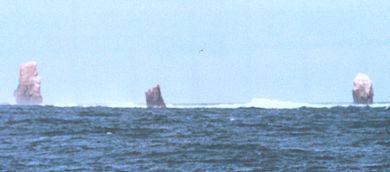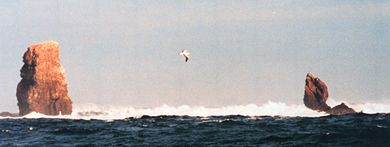
Rocas Alijos
Encyclopedia



Volcano
2. Bedrock3. Conduit 4. Base5. Sill6. Dike7. Layers of ash emitted by the volcano8. Flank| 9. Layers of lava emitted by the volcano10. Throat11. Parasitic cone12. Lava flow13. Vent14. Crater15...
islets or above-water (as well as below-water) rocks in the Pacific Ocean
Pacific Ocean
The Pacific Ocean is the largest of the Earth's oceanic divisions. It extends from the Arctic in the north to the Southern Ocean in the south, bounded by Asia and Australia in the west, and the Americas in the east.At 165.2 million square kilometres in area, this largest division of the World...
at 24°57′31"N 115°44′59"W. They are part of Comondú municipality
Municipalities of Baja California Sur
The Mexican state of Baja California Sur is divided into five municipalities :...
of the Mexican
Mexico
The United Mexican States , commonly known as Mexico , is a federal constitutional republic in North America. It is bordered on the north by the United States; on the south and west by the Pacific Ocean; on the southeast by Guatemala, Belize, and the Caribbean Sea; and on the east by the Gulf of...
state of Baja California Sur
Baja California Sur
Baja California Sur , is one of the 31 states which, with the Federal District, comprise the 32 Federal Entities of Mexico. Before becoming a state on October 8, 1974, the area was known as the South Territory of Baja California. It has an area of , or 3.57% of the land mass of Mexico and comprises...
, and situated about 300 km west of the mainland. The total surface area is less than 1,000 square metres. The official area figure of 0.012 km²http://mapserver.inegi.gob.mx/geografia/espanol/datosgeogra/extterri/frontera.cfm?c=154 (12,000 m²) appears too high in comparison with photographs.
The group consists of three principal rocks and numerous smaller ones. South Rock, the largest of the group, is 34 meters high, with a diameter of only 14 meters (position 24°57′03"N 115°44′55"W). Middle Rock is 18 meters high and about 10 meters in diameter. North Rock, 200 meters north of South Rock, is 22 meters high, with a diameter of 12 meters. The rocks in in between those are either submerged or so low that they are barely visible among the heavily breaking waves. The rocks seem to be known since the early Spanish history of Mexico; they can be found on a map from 1598. The first description is from 1704, by pirate John Clipperton. But only in 1791 the first exact description was made by a Spanish sailor. South Rock was climbed for the first time in 1990 by an expedition (October 31 through November 07, 1990) under the leadership of Robert W. Schmieder (Bob), who edited a monograph
Monograph
A monograph is a work of writing upon a single subject, usually by a single author.It is often a scholarly essay or learned treatise, and may be released in the manner of a book or journal article. It is by definition a single document that forms a complete text in itself...
about the rocks Rocas Alijos: Scientific Results from the Cordell Expeditions
The group is located at the transition zone between two major biologic provinces, at a latitude where the Pacific Current turns westward to form the North Pacific trans-oceanic current. The rocks are nesting sites of many sea birds.
The two other Mexican island groups in the Pacific Ocean that are not on the continental shelf
Continental shelf
The continental shelf is the extended perimeter of each continent and associated coastal plain. Much of the shelf was exposed during glacial periods, but is now submerged under relatively shallow seas and gulfs, and was similarly submerged during other interglacial periods. The continental margin,...
are Guadalupe Island
Guadalupe Island
Guadalupe Island, or Isla Guadalupe is a volcanic island located 241 kilometers off the west coast of Mexico's Baja California peninsula and some 400 kilometers southwest of the city of Ensenada in Baja California state, in the Pacific Ocean...
and Revillagigedo Islands
Revillagigedo Islands
The Revillagigedo Islands or Revillagigedo Archipelago are a group of four volcanic islands in the Pacific Ocean, known for their unique ecosystem...
.
Fauna
The breeding marine avifauna of Alijos Rocks currently consists of Leach's Storm-PetrelLeach's Storm-petrel
The Leach's Storm Petrel or Leach's Petrel is a small seabird of the tubenose family. It is named after the British zoologist William Elford Leach....
(a presumed breeder, probably a few pairs), Red-billed Tropicbird
Red-billed Tropicbird
The Red-billed Tropicbird, Phaethon aethereus, also known as the Boatswain Bird is a tropicbird, one of three closely related seabirds of tropical oceans.-Distribution and habitat:...
(14 birds), Masked Booby
Masked Booby
The Masked Booby, Sula dactylatra, is a large seabird of the booby family, Sulidae. This species breeds on islands in tropical oceans, except in the eastern Atlantic; in the eastern Pacific it is replaced by the Nazca Booby, Sula granti, which was formerly regarded as a subspecies of Masked Booby...
(100), and Sooty Tern
Sooty Tern
The Sooty Tern, Onychoprion fuscatus , is a seabird of the tern family . It is a bird of the tropical oceans, breeding on islands throughout the equatorial zone. Colloquially, it is known as the Wideawake Tern or just wideawake...
(250). Magnificent Frigatebird
Magnificent Frigatebird
The Magnificent Frigatebird was sometimes previously known as Man O'War, reflecting its rakish lines, speed, and aerial piracy of other birds....
is a regular winter visitor but
probably does not breed. Laysan Albatross
Laysan Albatross
The Laysan Albatross, Phoebastria immutabilis, is a large seabird that ranges across the North Pacific. This small two-tone gull-like albatross is the second most common seabird in the Hawaiian Islands, with an estimated population of 2.5 million birds, and is currently expanding its range to new...
is currently an annual visitor to Alijos Rocks during its winter breeding season, and may start to nest there in the near future.
External links
- mariner's description
- more detailed mariner's description in German
- sailing directions
- Rocas Alijos: Scientific Results from the Cordell Expeditions
- The Marine Birds of Alijos Rocks, Mexico
- Cordell Expeditions Homepage
- Rocas Alijos part of Comondú municipality
- Video: Tuna fishing at Alijos Rocks, October 2005
Literature
- Robert W. Schmieder, Ed.: Rocas Alijos: Scientific Results from the Cordell Expeditions, Dordrecht; Boston: Kluwer Academic Publishers, 1996, ISBN 0-7923-4056-6 (Series: Monographiae biologicae, v. 75)

